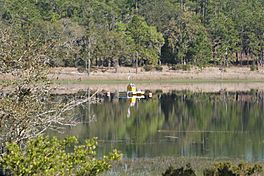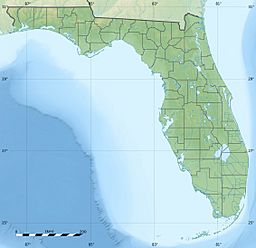Lake Barco facts for kids
Quick facts for kids Lake Barco |
|
|---|---|

Scientific buoy on Lake Barco
|
|
| Coordinates | 29°40′34″N 82°00′31″W / 29.6760°N 82.0085°W |
| Type | Lake |
| Basin countries | United States |
Lake Barco is a lake in Putnam County, Florida, United States. It is part of the Ordway-Swisher Biological Station, which is managed by the Institute of Food and Agricultural Sciences. The lake is shaped like a circle and is about 200 meters (656 feet) wide. The closest town is Melrose, Florida, which is about 5 kilometers (3 miles) to the northwest.
Contents
How Lake Barco Formed
Lake Barco is a special type of lake called a sinkhole lake. These lakes are common in Florida. They form when the ground above a cave or empty space collapses. This happens because the rock underneath, called limestone, can dissolve easily in water.
The bottom of Lake Barco has a lot of rich, dark soil. Below this soil is an underground water layer, or aquifer, made mostly of sand. Even deeper, there are layers of clay and sand that water can pass through. Below all of this is the main underground water source for Florida, called the Floridan aquifer.
Studying the Water
Scientists have placed special wells around Lake Barco and a nearby lake called Lake Suggs. These wells help them study how water moves in the area. This study of water is called hydrology.
The lake's average yearly temperature is about 20 degrees Celsius (68 degrees Fahrenheit). It gets about 1,280 millimeters (50 inches) of rain each year. Water flows into the lake all year long. Shallow underground water feeds the lake from the north and northeast. This water then slowly seeps out towards the west and south. There is also deeper underground water that flows beneath the lake.
Scientists use special methods to study the water in the lake. They have found that some water from the lake evaporates into the air. Other water flows downward into the deep Floridan aquifer.
Around the 1950s, the lake started to become more acidic. This was likely due to chemicals called sulfates in the air. These sulfates came from industrial activities and were absorbed by the lake water. As water moves through the lake's bottom, which has a lot of organic material, the water changes. It loses some of its oxygen as it passes through these sediments.
Animals and Plants Around the Lake
The area around Lake Barco is covered by evergreen forests and mixed areas of shrubs and grass. Many animals use the lake and its surroundings.
Who Lives Here?
- Amphibians: Many amphibians, like frogs, use the lake to lay their eggs and raise their young. This includes the gopher frog, which is a protected species.
- Mammals and Birds: The lake is an important place for mammals and birds to drink water.
- Tiny Organisms: The National Ecological Observatory Network is a group that studies nature. They collect samples from the lake to learn about the tiny living things in the water. These include very small organisms called microbes, larger water insects called macroinvertebrates, and tiny floating creatures called zooplankton.


